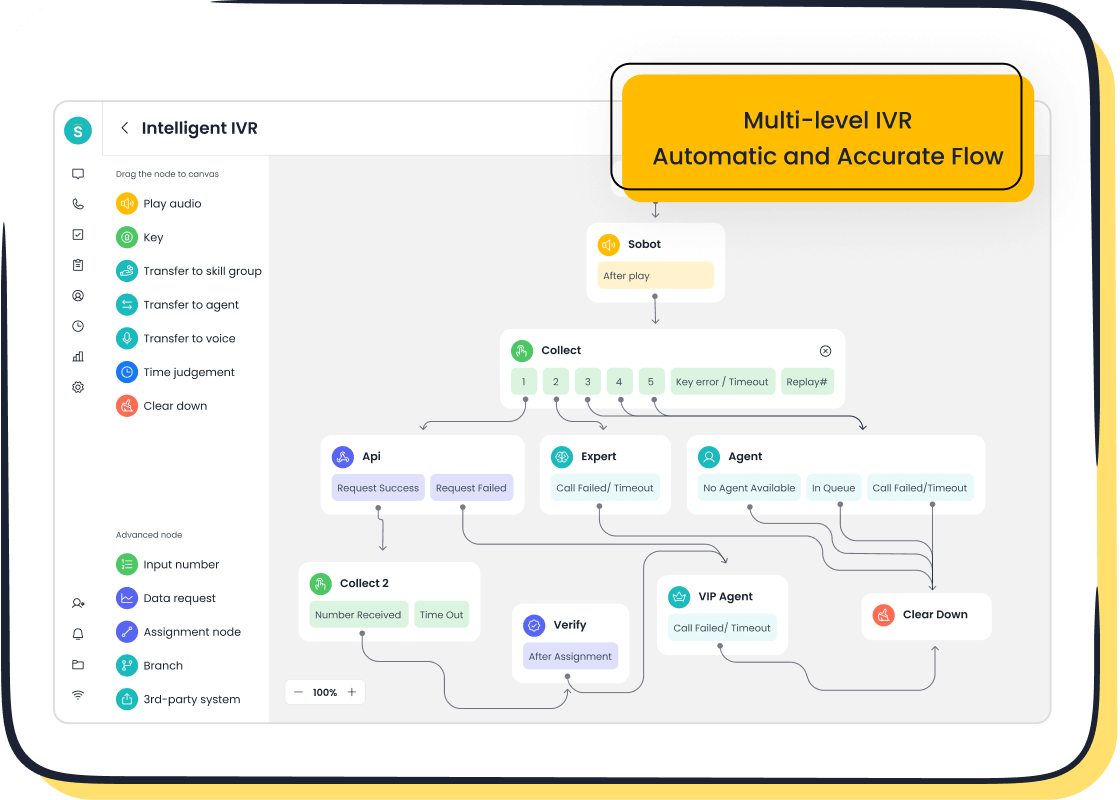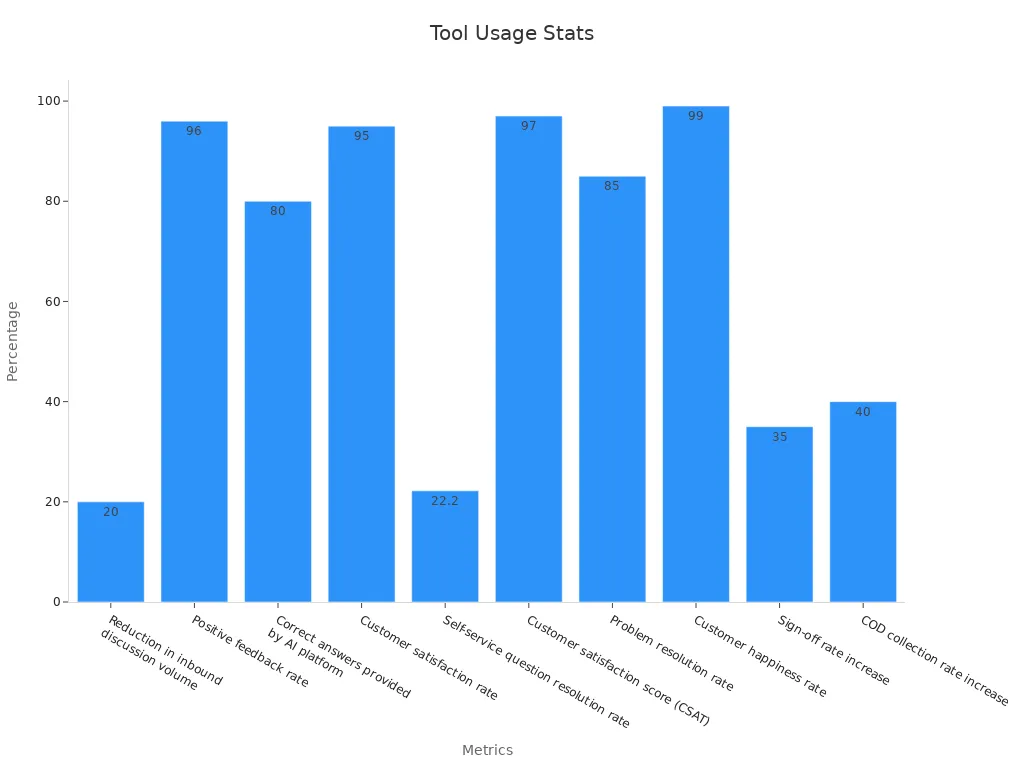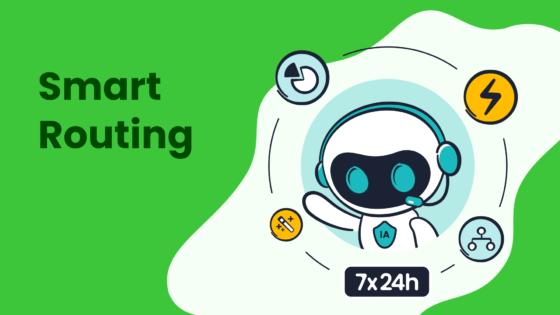How to Develop a Proactive Customer Care Strategy

Proactive customer care focuses on addressing issues before they arise, ensuring smoother customer service experiences. By anticipating customer needs, you can enhance satisfaction and loyalty. For instance, 87% of customers prefer companies that proactively reach out for service-related issues. Tools like Sobot's Voice/Call Center simplify this process by offering features such as intelligent IVR and real-time call tracking.
Understanding Proactive Customer Care
Definition and Key Characteristics
Proactive customer care involves anticipating customer needs and addressing potential issues before they arise. Unlike traditional methods, this approach focuses on creating seamless customer service experiences by solving problems early. For example, notifying customers about service outages in advance or offering personalized recommendations based on their preferences are hallmarks of this strategy.

The proactive customer service market is growing rapidly. It was valued at $24.5 billion in 2023 and is expected to reach $58.9 billion by 2032, driven by advancements in AI and machine learning. Companies adopting this approach aim to deliver exceptional customer experiences while reducing operational costs. Tools like Sobot's Voice/Call Center, with features such as intelligent IVR and real-time call tracking, make it easier to implement proactive strategies effectively.
How Proactive Customer Care Differs from Reactive Approaches
Proactive customer care stands apart from reactive methods in several ways. The table below highlights key differences:
| Characteristic | Proactive Customer Care | Reactive Customer Care |
|---|---|---|
| Initiation of Contact | Company initiates contact with the customer | Customer reaches out first |
| Anticipation of Needs | Anticipates and addresses customer needs before they arise | Waits for customer to notify about issues |
| Customer Experience | Aims to create exceptional experiences that drive loyalty | Often addresses issues after they have caused frustration |
| Example | Informing customers of service outages in advance | Responding to customer complaints after they occur |
Proactive methods save time and effort for both you and your customers. For instance, 70% of organizations now invest in technologies that analyze intent signals to predict customer needs. This approach not only enhances satisfaction but also reduces support costs.
Real-World Examples of Proactive Customer Care
Many companies have successfully implemented proactive customer service strategies. For instance:
- Bank of America developed Erica, an AI-powered assistant, to provide personalized financial guidance. It served over 24 million users and improved satisfaction by 20%.
- Delta Airlines adopted advanced solutions to resolve customer issues efficiently, saving over $2 million in costs within three years.
- OPPO, a Sobot client, used chatbots to handle repetitive queries, achieving an 83% resolution rate and a 57% increase in repurchase rates.
These examples demonstrate how proactive customer care can transform your customer service operations and drive loyalty.
The Importance of Proactive Customer Care
Enhancing Customer Satisfaction and Retention
Proactive customer care plays a vital role in improving customer satisfaction and retention. By addressing customer service issues before they escalate, you create a smoother experience for your audience. Research shows that 70% of customers view brands more favorably when they proactively reach out. Additionally, 90% of consumers are willing to spend more when they receive excellent customer service. These statistics highlight the direct link between proactive customer service and improved customer satisfaction.
Proactive strategies also strengthen customer retention. Companies that adopt proactive customer support see a 15-20% increase in retention rates. For example, Sobot's Voice/Call Center enables businesses to anticipate customer needs through features like real-time call tracking and intelligent IVR. These tools help you resolve issues faster, ensuring customers feel valued and cared for. When customers experience this level of attention, they are more likely to stay loyal to your brand.
Building Brand Loyalty and Reputation
Proactive customer service not only resolves issues but also builds long-term trust. Studies reveal that 68% of consumers report a positive change in brand perception when they receive proactive notifications. Furthermore, 96% of customers are more likely to remain loyal to a brand after experiencing good customer service. This approach fosters stronger relationships and enhances your reputation in the market.
For instance, OPPO, a Sobot client, achieved an 83% chatbot resolution rate by implementing proactive solutions. This success led to a 57% increase in repurchase rates, showcasing how proactive care can drive loyalty. By using tools like Sobot's omnichannel solutions, you can deliver consistent and personalized service across all platforms, further solidifying your brand's reputation.
Gaining a Competitive Edge in the Market
In today's competitive landscape, proactive customer care gives you a significant advantage. Companies that treat customer service as a value center experience 3.5 times faster revenue growth. Additionally, businesses with robust omnichannel strategies retain 89% of their customers compared to 33% for weaker approaches. These figures underline the importance of proactive strategies in staying ahead of competitors.
Sobot's solutions, such as the AI-powered Voicebot, allow you to provide faster resolutions and enhanced customer experience. This not only improves customer satisfaction but also positions your brand as a leader in the industry. With the customer experience management market expected to grow to $52.54 billion by 2030, adopting proactive customer service ensures your business remains relevant and competitive.
Steps to Build a Proactive Customer Care Strategy

Identifying Customer Needs and Pain Points
Understanding your customers' needs is the foundation of a proactive customer service program. Start by gathering feedback through surveys, online reviews, and social media monitoring. Surveys can uncover preferences and challenges, while reviews provide unfiltered opinions. Social media offers real-time insights into emerging concerns. For example, tracking customer churn rates or analyzing drop-off points in conversion funnels can reveal areas where customers face friction.
Use tools like heatmaps to identify where users struggle on your website. Metrics such as average resolution time and conversion rates also highlight inefficiencies in your customer support. By addressing these pain points, you can create a smoother customer experience and improve customer satisfaction.
Leveraging Data and Analytics for Insights
Data and analytics play a critical role in shaping your proactive customer service program. Predictive analytics helps you anticipate customer needs and address potential issues before they arise. For instance, analyzing call center data can reveal trends in customer inquiries, enabling you to prepare solutions in advance.
Metrics like customer feedback and churn rates guide strategies to improve retention. Sobot's Voice/Call Center offers real-time call tracking and performance analytics, helping you evaluate agent effectiveness and personalize customer interactions. These insights not only enhance customer support but also drive better business outcomes.
Implementing Tools Like Sobot's Voice/Call Center
The right tools make proactive assistance seamless. Sobot's Voice/Call Center provides features like intelligent IVR, AI-powered Voicebot, and global number availability. These tools reduce inbound discussion volume by 20% and achieve a 96% positive feedback rate. The platform's unified workspace consolidates customer data, enabling agents to deliver faster resolutions.
For example, Sobot's AI capabilities ensure 80% accuracy in responses, improving problem resolution rates to 85%. By integrating these tools into your customer service strategies, you can enhance efficiency and elevate the customer experience.

Establishing Clear Processes for Proactive Engagement
Clear processes ensure consistency in your proactive customer service efforts. Set measurable goals and KPIs, such as employee productivity and customer happiness rates. Empower your agents with decision-making authority and access to customer data. For instance, Sobot's tools provide a unified workspace, allowing agents to address issues efficiently.
Regularly review performance metrics like resolution times and customer satisfaction scores. Use these benchmarks to refine your strategies and maintain high service standards. A well-structured process not only improves customer support but also strengthens your brand's reputation.
Team Training for Proactive Customer Care

Cultivating a Customer-Centric Mindset
Training your team to adopt a customer-centric culture is essential for proactive customer service. This mindset focuses on anticipating customer needs, offering solutions proactively, and building long-term relationships. For example, regularly seeking feedback and staying informed about industry trends can help your team deliver innovative solutions that exceed expectations.
The benefits of cultivating this mindset are clear. Improved customer support reduces ticket volume and response times. Enhanced customer experiences lead to higher satisfaction and fewer complaints. Increased customer retention builds trust and loyalty, while higher ROI results from better interactions and referrals. The table below summarizes these outcomes:
| Benefit | Description |
|---|---|
| Improved customer support | Proactive resolution enhances support quality, reducing ticket volume and response times. |
| Enhanced customer experiences | Anticipating needs leads to higher satisfaction and fewer complaints. |
| Increased customer retention | Proactive engagement builds trust and loyalty, essential for retention strategies. |
| Higher ROI | Improved service leads to increased revenue through better customer interactions and referrals. |
By fostering a customer-centric culture, you empower your team to deliver exceptional customer service.
Developing Skills Through Role-Playing and Scenarios
Proactive training strategies like role-playing and scenario-based exercises help your team master customer service skills. These methods simulate real-world situations, allowing agents to practice handling complex customer interactions. For instance, role-playing can prepare agents to address common issues or anticipate customer concerns effectively.
This hands-on approach improves problem-solving abilities and boosts confidence. Metrics such as customer satisfaction scores and employee productivity rates often improve after such training. Sobot’s tools, like the Voice/Call Center, can complement these exercises by providing real-time analytics to evaluate agent performance. By refining these skills, your team becomes better equipped to deliver proactive customer service.
Encouraging Collaboration and Knowledge Sharing
Collaboration and knowledge sharing are vital for a successful customer-centric culture. Facilitating connections among team members enhances the quality of customer support. For example, systematic exchanges of insights between agents can lead to faster resolutions and improved customer experiences.
Team-building activities also play a significant role. Studies show that 63% of leaders report improved communication among employees after such initiatives. These activities foster interpersonal connections, creating a culture of knowledge sharing. Platforms like Sobot’s unified workspace further streamline collaboration by consolidating customer data, enabling agents to work together seamlessly. This approach not only strengthens teamwork but also enhances customer satisfaction and loyalty.
Sustaining Proactive Customer Care Through Empowerment
Empowering Employees to Make Decisions
Empowering your team to make decisions is essential for proactive customer service. When employees have the authority to act, they can resolve issues faster and deliver personalized solutions. This approach reduces bottlenecks and enhances customer satisfaction. For example, Sobot’s unified workspace equips agents with real-time customer data, enabling them to make informed decisions without delays.
A study shows that empowered employees improve customer service by making quicker decisions, which boosts satisfaction and loyalty. Decision-making authority also fosters accountability and collaboration among team members. The table below highlights key insights:
| Evidence Description | Key Insight |
|---|---|
| Empowered employees improve customer service through quick decision-making. | Enhanced customer satisfaction and loyalty due to personalized service. |
| Decision-making authority promotes ownership and accountability among team members. | Encourages collaboration and investment in each other's ideas and decisions. |
| Employee empowerment enables quicker decision-making, reducing bottlenecks. | Enhances organizational agility and responsiveness to market changes. |
By empowering your team, you create a culture of trust and efficiency that drives proactive customer service.
Fostering Continuous Learning and Improvement
Continuous learning ensures your team adapts to evolving customer needs. Implementing AI-driven tools like Sobot’s Voice/Call Center helps analyze performance metrics and identify areas for improvement. For instance, automated performance analysis can highlight trends in customer inquiries, enabling your team to refine their approach.
Models like continuous learning algorithms and AI-driven A/B testing optimize customer support strategies. These tools adapt to shifting preferences and market trends, ensuring your team stays ahead. The table below outlines these models:
| Continuous Learning Model | Description |
|---|---|
| Continuous learning algorithms | Adapt to shifting customer preferences and market trends by analyzing data to identify emerging patterns. |
| Automated performance analysis | Utilizes AI to analyze performance metrics and provide actionable insights for improvement. |
| AI-driven A/B testing | Implements A/B testing to optimize customer service strategies in real-time, ensuring adaptability to changing circumstances. |
By fostering a learning culture, you equip your team with the skills to deliver exceptional customer service consistently.
Regularly Reviewing and Updating Strategies
Regular reviews keep your proactive customer service strategy effective. Use data-driven approaches to identify trends and refine your methods. For example, health scores forecast renewals and indicate churn risks, while cohort analysis groups customers based on traits to understand behavior.
Other methods include actionable insights and predictive analytics. These tools help you develop playbooks for customer success scenarios and forecast outcomes using historical data. Sobot’s analytics capabilities simplify this process by providing real-time insights into customer interactions.
- Health Scores: Forecast renewals and indicate churn risk, offering strategic guidance.
- Actionable Insights: Harness data to identify trends and develop playbooks for customer success scenarios.
- Cohort Analysis: Group customers based on traits to analyze behavior and build effective churn mitigation strategies.
- Predictive Analytics: Utilize historical data to forecast outcomes, enhancing proactive management of customer success.
By regularly updating your strategies, you ensure your customer support remains agile and effective, improving customer satisfaction and loyalty.
Proactive customer care drives business success by enhancing customer satisfaction and reducing repeat calls. For instance, 66% of U.S. respondents prefer brands offering proactive notifications. To build a strong strategy, monitor trends in support tickets, implement AI-driven tools, and close feedback loops. Tools like Sobot's Voice/Call Center simplify these processes, ensuring seamless customer service and improved customer experience.
FAQ
What is the main benefit of proactive customer service?
Proactive customer service improves satisfaction by addressing issues before they arise. For example, notifying customers about delays reduces frustration and builds trust.
How can Sobot's tools help with proactive customer care?
Sobot's Voice/Call Center offers features like intelligent IVR and real-time analytics. These tools help you anticipate customer needs and deliver faster resolutions.
Why is data important in proactive customer service?
Data reveals trends and pain points. For instance, analyzing call data helps you predict common issues, enabling you to prepare solutions in advance.
See Also
A Comprehensive Approach to Omnichannel Contact Center Solutions
Essential Practices for Effective Call Center Quality Management
Understanding QMS Principles for Call Center Success
Key Considerations for Selecting Social Media Support Tools
Enhancing SaaS Customer Support Through Live Chat Techniques